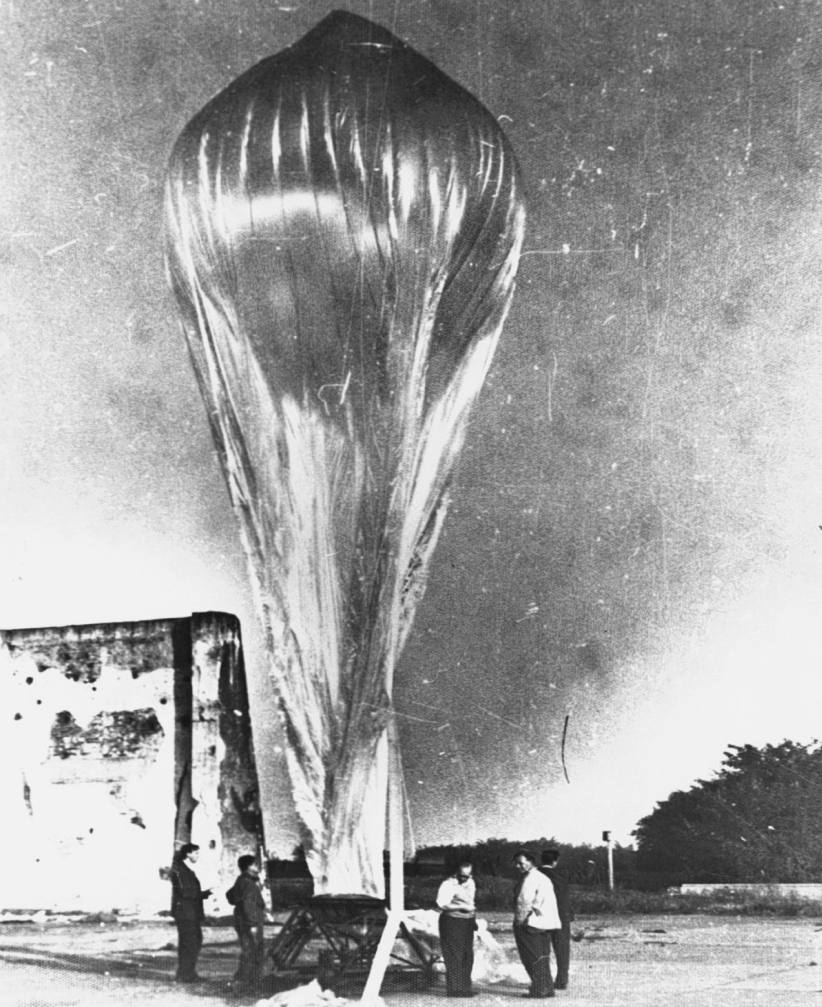Purpose of the flight and payload description
The G-Stack experiment was conceived as a high-altitude balloon mission using an enormous photographic emulsion stack to capture the tracks of cosmic-ray particles and their decay products at an altitude of approximately 30 kilometers. It was a landmark scientific endeavor undertaken in the early 1950s, with the primary goal of investigating the nature and decay properties of K mesons, a class of unstable particles whose behavior was poorly understood at the time. The initiative was part of a broader post-war effort in European physics to rejuvenate the field through international collaboration, symbolizing the transition from "small science" to "big science" and from cosmic-ray-based research to the emerging dominance of particle accelerators.
The collaboration involved six main laboratories from four European countries: Bristol in the UK; Milan and Padua in Italy; Dublin in Ireland; and Copenhagen in Denmark. The Italian groups provided critical technical expertise in both emulsion and balloon technologies and were deeply invested in the experiment's success, both scientifically and symbolically, as part of the post-war reconstruction of Italian physics.
The giant emulsion stack used during the G-Stack experiment was made up of 250 sheets, each with dimensions of 37 cm x 27 cm x 600 µm. When packed together, these sheets formed a solid block about 15 cm thick, with a total volume of 15 liters and a weight of 63 kg. The dimensions of the stack were chosen specifically to detect the complete tracks of secondary muons produced by Kµ decay, which typically have a range of about 20 cm. The stack was as large as technically possible due to two limitations: the maximum size of the individual sheets that could be produced in Bristol, and the total allowable load weight of approximately 140 kg, which corresponded-given the capabilities of the available balloons-to a maximum altitude of about 30 kilometers.
The balloon equipment included two clocks for load cut-off (the descent device consisted of two ordinary but robust kitchen clocks, as only such devices could reliably continue working at 30 km altitude in extreme environmental conditions); a parachute for landing the load (which likely failed to deploy); a radar reflector and three separate radio transmitters for tracking the balloon; and a chain of about fifteen sandbags with open ends made of polyethylene, serving as ballast.
Details of the balloon flight
Balloon launched on: 10/12/1954
Launch site: Novi Ligurie, Piamonte, Italy
Balloon launched by: MILAN
Balloon manufacturer/size/composition: Zero Pressure Balloon 4.000 m3
End of flight (L for landing time, W for last contact, otherwise termination time): 10/12/1954
Balloon flight duration (F: time at float only, otherwise total flight time in d:days / h:hours or m:minutes - ): ~ 8 h
Landing site: Near Berceto, Italy
Payload weight: 63 kg
Overall weight: 140 kgs
The G-Stack was launched aboard a high-altitude polyethylene balloon from Novi Ligure in Piemonte, northern Italy on October 12, 1954. The site was chosen after a careful survey of the direction of the stratospheric winds. Because of the huge cost of the emulsion and the complexity of the ?ight, it was decided to make a single launch with a 100% prevision of successful recovery. That was the reason that the flight originally planned for October 4th, was postoponed day after day waiting for the ideal conditions.
After launched in the early morning, the balloon -in?ated with hydrogen measuring about 4,000 m3 of volume- ascended at a speed of about 200 m/min, in the initial stages, and eventually reached an altitude of 27 km m in the course of about 2 hours. During this period it moved southwards and out over the Gulf of Genoa. After reaching the maximum altitude, it drifted slowly towards east and at the time of the cut-o?, after a ?ight of 8 hours, it was at about 24 km and over the Northern Apennines. The cargo landed near Cerreto pass and Cisa pass where it was recovered the day after in Berceto. During descent the parachute did not work but as the load landed on a tree almost 90% of the emulsion sheets were recovered undamaged.
The emulsion stack was brought to Milan for initial inspection and subsequent distribution for processing
External references
- 70 anni fa l'esperimento G-Stack dall'aeroporto Novi Ligure Il Moscone website
- 70° anniversario dell'esperimento G-Stack Citta di Novi Ligure website
- Analysis of some t-mesons Nuovo Cim 4 (Suppl 2), 221-223 (1956)
- Dall'aeroporto di Novi alle stelle: la storia del lancio della sonda G-Stack La Stampa website
- G-Stack, tre giorni per ricordare l'esperimento nei cieli di Novi NoviOnline
- Heavy mesons and hyperons giving rise to capture stars Supplemento al Nuovo Cimento, Vol IV, serie X: 465, 1956
- Mass measurements on fast particles from stars Nuovo Cim 4 (Suppl 2), 487-489 (1956)
- Observations on heavy Mesons and Hyperons Nature, 175 (4466), 971
- Observations on Heavy Mesons Secondaries (G-Stack Collaboration) Suppl. Nuovo Cimento, 6, Ser. X, No. 2 (1956) 398-424
- On the Masses and Modes of Decay of Heavy Mesons produced by Cosmic Radiation (G-Stack Collaboration) Il Nuovo Cimento 2 (1955) 1065-1102
- Recent advances in our knowledge of heavy mesons and hyperons Nuovo Cim 4 (Suppl 2), 337-350 (1956)
- The Discreet Charm of the Nuclear Emulsion Era Annual Review
of Nuclear and Particle Sciences 52 (2001) 1-21 - The G-Stack collaboration (1954): a case study in scienti?c ballooning history Tesi di Dottorato di Ricerca di Cristina Olivotto, Universita di Milano, 2006-2007
- The G-Stack Collaboration (1954): An Experiment of Transition Historical Studies in the Natural Sciences Vol. 39, No. 1 (Winter 2009), pp. 63-103
10714If you consider this website interesting or useful, you can help me to keep it up and running with a small donation to cover the operational costs. Just the equivalent of the price of a cup of coffee helps a lot.


